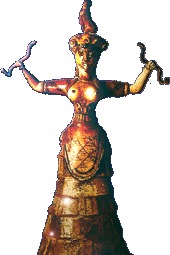GOD
A
D
O
N
A
I
Y
A
H
W
E
H
C
H
I
Kundalini Awakening
Kundalini literally
means coiling, like a snake. In the classical literature of hatha
yoga kundalini is described as a coiled serpent at the base of the
spine. The image of coiling, like a spring, conveys the sense of untapped
potential energy. Perhaps more meaningfully kundalini can be described as a great reservoir of creative energy at the base of the
spine. It's not useful to sit with our consciousness fixed in our
head and think of kundalini as a foreign force running up and down
our spine. Unfortunately the serpent image may serve to accentuate
this alien nature of the image. It's more useful to think of kundalini
energy as the very foundation of our consciousness so that when kundalini
moves through our bodies our consciousness necessarily changes with
it.
described as a great reservoir of creative energy at the base of the
spine. It's not useful to sit with our consciousness fixed in our
head and think of kundalini as a foreign force running up and down
our spine. Unfortunately the serpent image may serve to accentuate
this alien nature of the image. It's more useful to think of kundalini
energy as the very foundation of our consciousness so that when kundalini
moves through our bodies our consciousness necessarily changes with
it.
The concept of kundalini can also be examined from a strictly psychological perspective. From this perspective kundalini can be thought of as a rich source of psychic or libidinous energy in our unconscious. |
In
the classical literature of Kashmir Shaivism kundalini is described
in three different  manifestions.
The first of these is as the universal energy or para-kundalini.
The second of these is as the energizing function of the body-mind
complex or prana-kundalini. The third of these is as consciousness
or shakti-kundalini which simultaneously subsumes and intermediates
between these two. Ultimately these three forms are the same but understanding
these three different forms will help to understand the differerent
manifestations of kundalini. manifestions.
The first of these is as the universal energy or para-kundalini.
The second of these is as the energizing function of the body-mind
complex or prana-kundalini. The third of these is as consciousness
or shakti-kundalini which simultaneously subsumes and intermediates
between these two. Ultimately these three forms are the same but understanding
these three different forms will help to understand the differerent
manifestations of kundalini. |
B
U
D
D
H
A
E
L
O
H
I
M
L
O
R
D